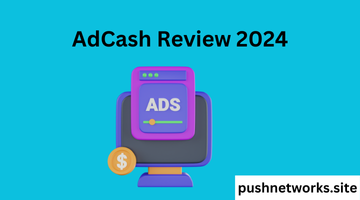What is AdCash
AdCash is a digital advertising network that connects advertisers with publishers. It provides a platform for businesses to promote their products or services through various ads, including display, mobile, video, and native ads. Conversely, publishers can monetize their websites or apps by displaying these ads and earning revenue based on impressions, clicks, or other performance metrics.
The network typically offers real-time analytics, targeting options, and optimization tools to help advertisers and publishers achieve their goals. AdCash is known for its global reach and ability to deliver ads to a broad audience across different geographies and devices.
Pros:
- Global Reach: AdCash offers extensive international coverage, allowing advertisers to target audiences in various regions and countries.
- Diverse Ad Formats: The platform supports multiple ad formats, including display, mobile, video, and native ads, giving advertisers flexibility in their campaigns.
- Advanced Targeting: AdCash provides sophisticated targeting options, such as geo-targeting, demographic targeting, and interest-based targeting, which can help improve ad relevance and performance.
- Real-Time Analytics: Advertisers and publishers can access real-time data and reporting tools, which can help track performance, optimize campaigns, and make data-driven decisions.
- Optimization Tools: AdCash offers tools for campaign optimization, which can help maximize return on investment (ROI) by adjusting bids, targeting, and ad placements based on performance data.
- Monetization Opportunities: Publishers can monetize their websites or apps through various ad formats, potentially increasing revenue streams.
Cons:
- Learning Curve: The platform’s features and options can be complex for beginners, requiring a learning curve to utilize all its capabilities thoroughly.
- Quality of Traffic: The quality of traffic and conversions can vary. Some users have reported concerns about bot traffic or low-quality leads, which can impact ROI.
- Cost: Depending on the targeting and competition, costs for advertising can be high, especially in competitive niches or regions.
- Support Issues: Some users have reported issues with customer support, including slow response times or challenges in resolving issues effectively.
- Ad Fraud Risks: As with many advertising networks, there is a risk of ad fraud, including click or impression fraud, which can impact campaign performance and costs.
- Performance Variability: Performance can vary based on factors such as the ad format used, the quality of the creative, and the competitiveness of the market, requiring ongoing monitoring and adjustments.
Overall, AdCash can be a valuable tool for digital advertising and monetization, but its effectiveness will depend on how well users leverage its features and manage potential challenges.
Setting up an account with AdCash involves several steps. Getting started is easy with the following general guide:
-
Sign Up:
- Visit the AdCash Website: Go to the AdCash homepage.
- Choose the Right Account Type: AdCash typically offers accounts for both advertisers and publishers. Select the type of account that fits your needs.
- “Sign Up” or “Get Started” will take you to the sign-up page. You’ll need to provide basic information such as your email address, company name, and contact details.
- Passwords should be strong so that you can secure your account.
- Verify Your Email: You’ll likely receive a verification email after registration. If you do not receive an email confirmation, follow its instructions.
- Complete Your Profile:
- Log In: Access your account using the credentials you created.
- Fill Out Profile Information: Complete your profile by providing additional details such as payment information, company details, and any other required information.
- Set Up Billing: You’ll need to set up billing information for advertisers. This may involve adding a payment method like a credit card or connecting to an alternative payment system.
- Create a Campaign (For Advertisers):
- Go to the Campaign Dashboard: Navigate to the section where you can create and manage ad campaigns.
- Define Your Campaign Goals: Specify your campaign objectives, such as brand awareness, lead generation, or sales.
- Choose Ad Formats: Select the ads you want to run (e.g., display, mobile, video, native).
- Set Targeting Options: Define your targeting parameters, including geographic location, demographics, interests, and devices.
- Set Budget and Bidding: Determine your budget and bid strategy. This involves setting how much you will pay per click, impression, or other metrics.
- Design Your Ads: Upload your ad creatives or design them using AdCash’s tools if available.
- Launch Your Campaign: Review all settings and launch your campaign once everything is set up.
- Set Up Ad Space (For Publishers):
- Go to the Publisher Dashboard: Access the area where publishers can set up and manage ad spaces.
- Add Your Website or App: Provide details about where you will be displaying ads, such as your website URL or app information.
- Generate Ad Code: Get the ad code or tags you need to place on your site or app. This code will enable AdCash to serve ads.
- Place the Code: Add the ad code to the designated areas on your site or app where you want ads to appear.
- Monitor Performance: Use AdCash’s tools to track the performance of the ads and optimize your settings as needed.
- Support and Optimization:
- Explore Resources: Familiarize yourself with AdCash’s support resources, such as guides, FAQs, and tutorials.
- Contact Support: If you encounter issues or have questions, contact AdCash’s support team for assistance.
- Optimize Campaigns: Regularly review your campaign performance and adjust to improve results based on analytics and feedback.
You can set up and start using your AdCash account effectively by following these steps.
Conclusion:
AdCash is a powerful, flexible platform that can drive effective digital advertising and monetization strategies. Its features support broad and targeted campaigns, though users should be prepared to navigate its complexities and address potential cost and traffic quality challenges. It can be a valuable tool for leveraging its extensive network and advanced capabilities.
